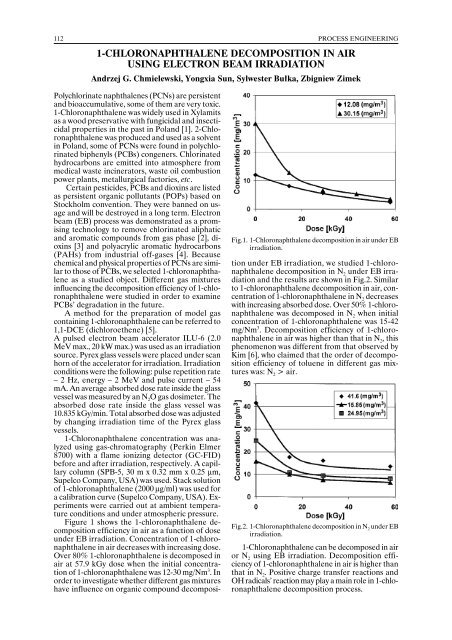annual report annual report annual report annual report 2005
annual report annual report annual report annual report 2005
annual report annual report annual report annual report 2005
You also want an ePaper? Increase the reach of your titles
YUMPU automatically turns print PDFs into web optimized ePapers that Google loves.
112<br />
1-CHLORONAPHTHALENE DECOMPOSITION IN AIR<br />
USING ELECTRON BEAM IRRADIATION<br />
PROCESS ENGINEERING<br />
Andrzej G. Chmielewski, Yongxia Sun, Sylwester Bułka, Zbigniew Zimek<br />
Fig.1. 1-Chloronaphthalene decomposition in air under EB<br />
irradiation.<br />
Polychlorinate naphthalenes (PCNs) are persistent<br />
and bioaccumulative, some of them are very toxic.<br />
1-Chloronaphthalene was widely used in Xylamits<br />
as a wood preservative with fungicidal and insecticidal<br />
properties in the past in Poland [1]. 2-Chloronaphthalene<br />
was produced and used as a solvent<br />
in Poland, some of PCNs were found in polychlorinated<br />
biphenyls (PCBs) congeners. Chlorinated<br />
hydrocarbons are emitted into atmosphere from<br />
medical waste incinerators, waste oil combustion<br />
power plants, metallurgical factories, etc.<br />
Certain pesticides, PCBs and dioxins are listed<br />
as persistent organic pollutants (POPs) based on<br />
Stockholm convention. They were banned on usage<br />
and will be destroyed in a long term. Electron<br />
beam (EB) process was demonstrated as a promising<br />
technology to remove chlorinated aliphatic<br />
and aromatic compounds from gas phase [2], dioxins<br />
[3] and polyacrylic aromatic hydrocarbons<br />
(PAHs) from industrial off-gases [4]. Because<br />
chemical and physical properties of PCNs are similar<br />
to those of PCBs, we selected 1-chloronaphthalene<br />
as a studied object. Different gas mixtures<br />
influencing the decomposition efficiency of 1-chloronaphthalene<br />
were studied in order to examine<br />
PCBs’ degradation in the future.<br />
A method for the preparation of model gas<br />
containing 1-chloronaphthalene can be referred to<br />
1,1-DCE (dichloroethene) [5].<br />
A pulsed electron beam accelerator ILU-6 (2.0<br />
MeV max., 20 kW max.) was used as an irradiation<br />
source. Pyrex glass vessels were placed under scan<br />
horn of the accelerator for irradiation. Irradiation<br />
conditions were the following: pulse repetition rate<br />
– 2 Hz, energy – 2 MeV and pulse current – 54<br />
mA. An average absorbed dose rate inside the glass<br />
vessel was measured by an N 2 O gas dosimeter. The<br />
absorbed dose rate inside the glass vessel was<br />
10.835 kGy/min. Total absorbed dose was adjusted<br />
by changing irradiation time of the Pyrex glass<br />
vessels.<br />
1-Chloronaphthalene concentration was analyzed<br />
using gas-chromatography (Perkin Elmer<br />
8700) with a flame ionizing detector (GC-FID)<br />
before and after irradiation, respectively. A capillary<br />
column (SPB-5, 30 m x 0.32 mm x 0.25 µm,<br />
Supelco Company, USA) was used. Stack solution<br />
of 1-chloronaphthalene (2000 µg/ml) was used for<br />
a calibration curve (Supelco Company, USA). Experiments<br />
were carried out at ambient temperature<br />
conditions and under atmospheric pressure.<br />
Figure 1 shows the 1-chloronaphthalene decomposition<br />
efficiency in air as a function of dose<br />
under EB irradiation. Concentration of 1-chloronaphthalene<br />
in air decreases with increasing dose.<br />
Over 80% 1-chloronaphthalene is decomposed in<br />
air at 57.9 kGy dose when the initial concentration<br />
of 1-chloronaphthalene was 12-30 mg/Nm 3 . In<br />
order to investigate whether different gas mixtures<br />
have influence on organic compound decomposition<br />
under EB irradiation, we studied 1-chloronaphthalene<br />
decomposition in N 2 under EB irradiation<br />
and the results are shown in Fig.2. Similar<br />
to 1-chloronaphthalene decomposition in air, concentration<br />
of 1-chloronaphthalene in N 2 decreases<br />
with increasing absorbed dose. Over 50% 1-chloronaphthalene<br />
was decomposed in N 2 when initial<br />
concentration of 1-chloronaphthalene was 15-42<br />
mg/Nm 3 . Decomposition efficiency of 1-chloronaphthalene<br />
in air was higher than that in N 2<br />
, this<br />
phenomenon was different from that observed by<br />
Kim [6], who claimed that the order of decomposition<br />
efficiency of toluene in different gas mixtures<br />
was: N 2 > air.<br />
Fig.2. 1-Chloronaphthalene decomposition in N 2<br />
under EB<br />
irradiation.<br />
1-Chloronaphthalene can be decomposed in air<br />
or N 2 using EB irradiation. Decomposition efficiency<br />
of 1-chloronaphthalene in air is higher than<br />
that in N 2 . Positive charge transfer reactions and<br />
OH radicals’ reaction may play a main role in 1-chloronaphthalene<br />
decomposition process.
















